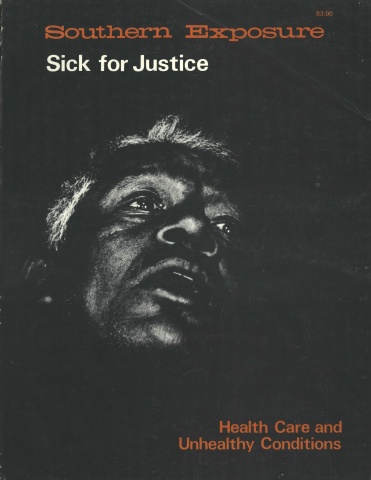Lessons from Community Clinics: Conflict and Democracy

This article originally appeared in Southern Exposure Vol. 6 No. 2, "Sick for Justice: Health Care and Unhealthy Conditions." Find more from that issue here.
Most Americans go to the offices of private physicians to receive their care in health and illness. For many, this is a satisfactory encounter even though the physician alone determines the fees, procedures, and hours he is available — indeed, every aspect of the relationship. But for those who may wish to improve or criticize the way in which health care services are delivered, there is little opportunity for discussion or bargaining as equals.
The patient is invariably in a poor position to engage in bargaining: he or she may be horizontal on an examining table, in a state of undress and anxious about the health care problem that prompted the visit. The result is that most people only have the alternative of voting with their feet: they can go to another doctor (if one is available in the rural community) or to another institution.
In the last decade, increasing numbers of clinics and health centers have opened in which the people of the community have some serious say-so about how it is run. Such organizations have varied greatly from rural nurse practitioner clinics to small family practice medical groups to large multi-specialty clinics. Some were organized out of struggles over issues in the community, while others were the fruit of an individual’s or organization’s concept of an improved health care delivery system.
Some health centers resulted from efforts of student and activist groups such as those at Vanderbilt and those who joined VISTA, while many are a direct response to federal programs like the Rural Health Initiatives. The dozen Rural Practice Project models with which I work are a much smaller demonstration of primary care in isolated rural areas. Some of the older Appalachian coal miner clinics were a consequence of leadership by the medical care program of the UMW Fund, and gradually made a transition to broad and representative board control. More recently, smaller clinics came about because of demands of the coal miners and their families.
In terms of total money and personnel, all such clinics and health centers in the country are but drops in the bucket in an enormous system which has successfully resisted change for decades. Yet the neighborhood health center movement pioneered health care teams, outreach staffs which included family health workers, and an approach toward comprehensive health services which embraced the usually neglected areas of transportation, social services and mental health.
Broad community representation on the boards of many of the new health centers has resulted in a sensitive response by physicians and other providers to the needs of the people in the community. Programs of care, as a result, have often been improved and broadened. At Fairmont Clinic in West Virginia, the lay board successfully called for and negotiated with the physician group to achieve a wide program of social services and outreach, all-day Saturday and evening physician hours at the clinic and the development of pharmacy, podiatry, optometry and optical services.
In some places the democracy of community control has worked out like a beautiful marriage in which there is conflict, but also discussion and respect resulting in cooperation and compromise. In other cases, each faction on the board, or the spokesperson for the board and the professionals, begin their angry responses with “you people” - which is usually a good signal that things have broken down into “us and them.”
Frequently, board members represent different interests and may have values and attitudes which differ from other community representatives as well as from those of the professionals. Power struggles may take place, not only between the community board and health care team members, but between differing community interests.
If there has not been a clear determination of what the role of the community board is and where the limits lie on the authority and responsibility of professionals, there is likely to be professional and administrative uncertainty throughout the organization. Indeed, some of the representative community boards for National Health Service Corps projects, RHIs and other federal programs spend a great deal of time and energy trying to resolve internal relationships and conflicting opinions. Although participation in decision-making can lead to individual development as well as an increased sense of social responsibility, often the HEW constraints requiring breadth of community representation are not followed up with a program for training leadership and educating boards on the policy issues they will encounter.
The excessive conservatism of most physicians is ideally balanced when the community has an opportunity for representation in the delivery of health services. As more and more doctors turn toward group practice, it has become apparent that the old idea that these medical groups, by themselves, would somehow benefit patients equally with physicians has proved to be a myth.
Because the nation has not yet achieved a national health service program or national health insurance, it is important that there be continued experimentation with different models to determine the best ways to serve the health needs of the community. Increasingly, the federal government will come up with regulations governing the clinics and health centers despite the very different needs of their communities and the origins of their structure and organization. Whether it is a bread-and-butter issue, like a single pattern for Medicaid reimbursement, or the direction a national health service program should take, it is essential that there be debate and discussion about improved community representation in health care and the variety of ways to deliver that care to the people.
Tags
M.H. Ross
M.H. Ross is associate director of the Rural Practice Project in Chapel Hill, North Carolina. (1978)